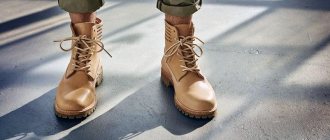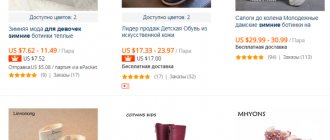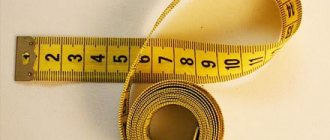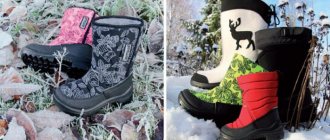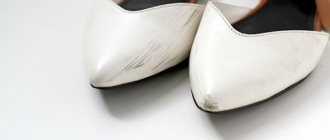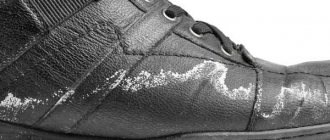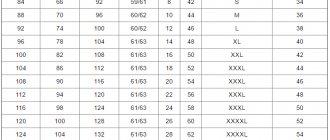Shoe size: table for children by age. If you need to buy your child new boots or sandals, parents, as a rule, take their child with them to the store. How else to choose shoes that fit so that they are not tight or, on the contrary, too loose. But what if beautiful shoes should become a pleasant surprise? How to make a purchase without a child so that the shoes fit? This is possible if you know the exact size.
How to determine a child's shoe size
To choose the “right” shoes, you need to take measurements of the child’s feet. First, an imprint of the foot is made, the beginning from the big toe and the end along the heel are recorded. Then you will need a tailor's meter or ruler. The distance between the extreme points of the foot image is measured. If the child is small and cannot walk yet, the foot is measured while the baby is sitting. Older preschoolers and schoolchildren's feet are measured while they are standing.
The most accurate measurements can be obtained if you measure your foot in the evening. By this time, the legs have increased slightly in size. Moreover, it is not enough to measure only, for example, the left foot. You will definitely need measurements on the right one too. As a rule, people have one leg that is slightly different from the other, a little larger. Shoe purchases should be made based on a larger size.
The data obtained should be compared with the generally accepted table of shoe sizes. This way you can understand what kind of shoes your child needs.
By the way, when choosing shoes, you need to pay attention to the fact that there should be a small distance between the big toe and the end of the sole, about half a centimeter. After all, a child walks and runs, and the foot moves as it moves, so boots or shoes bought in the same size will turn out to be tight, will rub their feet, and will quickly fail.
When choosing shoes, you should also consider fullness. The manufacturer always indicates what kind of foot the shoes are made for, for fat or thin, with high or low instep.
How to take measurements correctly
Before purchasing from an online store, be sure to take measurements of your child’s feet. Incorrectly taken measurements may result in incorrectly selected shoes. Therefore, we recommend that you familiarize yourself with the basic rules:
- Measure your foot size in the evening. At this time, the leg is trampled and enlarged by 5-8%.
- To measure, take a sheet of A4 paper and place the baby on it (it is advisable that he stands and not sits, as the leg will be trampled more easily).
- Trace both legs with a pencil, or just mark the edges at the big toe and the base of the heel. Use a ruler to measure the distance from the extreme points. Be sure to measure both legs and choose the length that turns out to be longer.
- Add 10-15 mm to the resulting length. An adult's little finger should fit between the back and the leg without any problems. This does not apply to orthopedic shoes; here you need to choose ones without gaps.
- If your baby is too small for such procedures, then measure the foot with a regular string.
The resulting parameter will help you navigate the tables below. Just find the resulting value in the table and look at the bottom line for your size. Good luck!
How to choose the right shoes for your child
You need to be extremely careful when choosing the very first shoes for your baby. Experts advise taking into account the following nuances:
- Boots must have flexible soles. It’s already difficult for a child to take his first steps, and if at the same time the hard material of the sole does not allow him to place his foot properly, it’s absolutely sad.
- Heavy boots are only suitable for special forces soldiers. For children, you need to choose lightweight models so that your legs don’t get tired when walking.
- Natural materials are required! Such shoes dry quickly, they are easy to wash and clean, and since kids are not very neat, this quality of footwear is necessary. However, mothers should remember that shoes can easily be damaged if they are dried directly next to a radiator: hot air will play a bad role - the insoles will become deformed, and the material from which the shoes are made will quickly become unusable.
- In babies, as a rule, the foot closer to the toes is wider than the heel. Therefore, you should not forget about this feature when choosing boots.
- Children often have a high instep. Therefore, when buying shoes for such kids, you need to choose models that are wide, but with a lock. The fixator will help to fix the foot in the shoe correctly, without dragging it.
- A shock absorber is required. High-quality children's boots are equipped with this feature.
- Shoes need to be selected according to size to avoid squelching. When a child walks in shoes that do not fit him, not only do his feet begin to form incorrectly, but he also develops clumsiness, which can become a habit, which will affect his gait and posture. In addition, fatigue appears in the legs, and the child begins to feel unwell.
When choosing shoes for your baby, you need to place the child’s foot tightly, moving it to the front of the shoe, and try to squeeze your finger between the heel and heel. If the toe fits in smoothly, but there is no more free space left, then the shoe fits correctly. The other shoe on the other foot is checked in the same way. Only after this verification can you make a purchase.
Mandatory requirements for a child's first shoes
There are some requirements developed by domestic experts:
- It is necessary to have a hard back, a heel of 3-5 cm, and a soft instep support;
- non-slip sole;
- made from breathable materials - genuine leather, textiles;
- closed cape so that fingers are not damaged if the child stumbles;
- The ankle joint should be well fixed, this will prevent the legs from moving inside.
One of the most important requirements is that the size must match your current foot size. If the model is too tight, blood circulation will be impaired.
Country Size Charts
When choosing shoes, you need to take into account the labeling, because each country has its own canons.
In the CIS countries, Russia, European territory and China, the metric system has been introduced. That is, the size of the foot is calculated in millimeters. The sizes are approximately similar.
In the UK, the inch is used, so shoe sizes are calculated in inches. There are 25.4 millimeters per inch.
French shoemakers use touches. One stroke accounts for 2/3 of a centimeter. Moreover, you need to measure the insole.
In the USA, as well as in England, inches are used to measure. Foot measurements are taken.
Accordingly, the size table in different countries looks like this.
| England | USA | Europe | China |
| 0 | 1 | 16 | 9,5 |
| 0-1 | 1,2 | 16,5 | 10 |
| 1 | 2 | 17 | 10,5 |
| 1,5 | 2,5 | 18 | 11 |
| 2,5 | 3 | 19 | 11,5 |
| 3 | 4 | 19,5 | 12 |
| 4 | 5 | 20 | 12,5 |
| 4,5 | 5,5 | 21 | 13 |
| 5 | 6 | 22 | 13,5 |
| 5,5 | 6,5 | 22,5 | 14 |
| 6-6,5 | 7 | 23 | 14,5 |
| 7 | 8 | 24 | 15 |
| 7,5 | 8,5 | 25 | 15,5 |
| 8 | 9 | 25,5 | 16 |
| 8,5 | 9,5 | 26 | 16,5 |
| 9-9,5 | 10-10,5 | 27 | 17 |
| 10 | 11 | 28 | 17,5 |
| 10,5 | 11,5 | 28,5 | 18 |
| 11 | 12 | 29 | 18,5 |
| 11,5 | 12,5 | 30 | 19 |
| 12 | 13 | 31 | 19,5 |
| 12,5 | 13,5 | 31,5 | 20 |
| 13 | 1 | 32 | 20,5 |
| 1 | 1,5-2 | 33 | 21 |
| 1,5 | 2,5 | 34 | 21,5 |
| 2,5 | 3,5 | 35 | 22,5 |
What to consider?
When choosing shoes and sneakers for their child, parents should consider several important nuances. Shoes should be made of natural materials. Leather and suede are best. You cannot buy sandals or sneakers for growth. Firstly, it will be uncomfortable for the child to walk, and secondly, this can lead to him stumbling, falling and injuring himself. Another important aspect is the height of the leg lift. When choosing shoes and sandals, you should definitely take this aspect into account. And, of course, it is important to pay attention to such a moment as the fullness of the leg.
Shoe size: table for children by age in Russia
| Age | Size |
| From 3 months up to six months | 16; 16,5, 17 |
| From six months to 9 months. | 18; 19 |
| From 9 months up to a year | 19,5; 20 |
| From a year to a year and a half | 20-22 |
| From one and a half to 2 years | 22-23 |
| From 2 to 3 years | 23-25 |
| From 3 to 4 years | 25-26 |
| From 4 to 5 years | 26-28 |
| From 5 to 6 years | 28-30 |
| From 6 to 7 years | 30-31 |
| From 7 to 8 years | 31-32 |
| From 8 to 10 years | 33-35 |
For boys
Boys have a different physical development than girls; their feet grow faster. Therefore, the size table looks like this:
| Boy, age | Size |
| From 3 months to six months | 16; 16,5; 17 |
| From six months to 9 months. | 18; 19 |
| From 9 months up to a year | 19,5; 20 |
| From 12 months up to 18 months | 21; 22 |
| From 2 to 3 years | 22,5 |
| From 4 to 5 years | 25,5; 26 |
| From 5 to 6 years | 28; 28,5 |
| From 6 to 8 years | 30; 31 |
| From 8 to 12 years | 33; 34; 35; 36 |
Standard sizes of popular brands
Unfortunately, modern shoe manufacturers are increasingly moving away from generally accepted standards when developing their own sizing chart. That is why, before purchasing a particular product, you should definitely familiarize yourself with the compliance of its sizes.
"Kotofey"
The assortment of this Russian manufacturer is quite impressive, because in addition to summer, winter and sports shoes, it also offers models with orthopedic insoles. And in order not to get confused in all this diversity, you should carefully study the following data table:
"Kapika"
The model range of this manufacturer includes more than a thousand pieces for every taste, color and size. The universal auxiliary size table will also help you determine the last parameter.
"Nike"
Is it worth advertising shoes from the sports brand Nike, because they have long earned worldwide popularity? This success is explained not only by the spectacular design and high quality of the product, but also by its convenient size chart, determined in accordance with the following table:
See also:
How to make slime from PVA glue - slime at home
